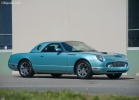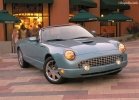Test drive Ford Thunderbird 2000 - 2005 convertible
Thunder days
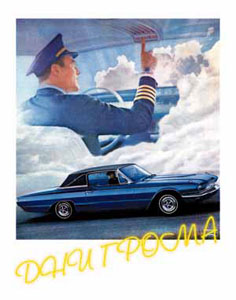 The North American Indians, who once inhabited the forests of the eastern coast and great plains, sacredly believed in the existence of terrible birds with huge wings and human faces. Inhabited somewhere halfway between the earth and paradise, they personified the highest power and were a link connecting with the gods.
The North American Indians, who once inhabited the forests of the eastern coast and great plains, sacredly believed in the existence of terrible birds with huge wings and human faces. Inhabited somewhere halfway between the earth and paradise, they personified the highest power and were a link connecting with the gods. The waves of their wings gave birth to the peals of thunder, and the sparkling sparkling from the eyes painted lightning in the sky. Therefore, this feathered name was the appropriate - Thunderbird, that is, the thunder -bird. Since such pretty birds were considered the lords of the rain, and hence the symbol of fertility, the Indians took them the most honorable place at the top of the sacred totemic pillars, in which religious rites and sacrifices took place.
In 1953, in the automotive capital of America, Detroit, thunder also thundered and lightning sparkled when the leadership of the General Motors corporation became aware that Ford, bypassing competitors, registered the word Thunderbird as the name of his new model. A good name for a sports car. Namely, a sports car - at least at the design stage - the first Thunderbird was conceived, or, out of an American habit of reducing everything that you can, T -Bird.
They say that real life begins after forty. In this case, everything that happened to T-Bird for its more than forty-year-old history should become only a preface to something out of the ordinary. So (or something like this) was considered until recently, until at the beginning of 1997 it became known about Ford's intention to stop the release of this model by the end of the year. What gives an occasion to tell about her birth and early youth.
America and the car. In this, for more than a hundred years, a love novel, which lasted for more than a hundred years, turned out to be a great many different four -wheeled crews. But only a few of them sunk into the soul of an average American as deep as Ford T-Bird. Today it belongs to the category of the most noticeable names in American automobile history.
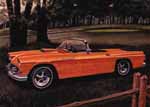 Although this car for more than four decades was an integral part of the American landscape, cars of the early series are of greatest interest. It was they who were a symbol of the great American dream. How else can the appearance of such a number of popular songs that mention the name of the machine? In the early sixties, for example, the Beach Boys group burst into small towns, singing: Sheoll Have Fun, Fun, Fun Till Her Daddy Takes The T-Bird Away. Two dozen years later, Prince, a native of Detroit, sang: IOM gonna drive my daddyos thunderbird ....
Although this car for more than four decades was an integral part of the American landscape, cars of the early series are of greatest interest. It was they who were a symbol of the great American dream. How else can the appearance of such a number of popular songs that mention the name of the machine? In the early sixties, for example, the Beach Boys group burst into small towns, singing: Sheoll Have Fun, Fun, Fun Till Her Daddy Takes The T-Bird Away. Two dozen years later, Prince, a native of Detroit, sang: IOM gonna drive my daddyos thunderbird .... Now, becoming a classic, T-Bird has taken an honorable place in commercials, rises high above the human stream on the signs of roadside cafes and restaurants, is the pride of numerous owners and collectors. Without a doubt, the image of T-Bird has grown firmly with American mass culture.
After a period of some stagnation, T-Bird by the end of the 80s again regained the image of an attractive dynamic machine, but still the majority is sure that his truly golden age came in 1955-1966. During this relatively short period, three generations of a car, united by one common feature - a two -door body, were released from each other. Later, the cars received the nicknames of Littlebird - a bird, Squarebird - a difficult combination, something like a broad -shouldered one, and Bigbird is a large bird. Each option was and remains warmly beloved, and that dozen years and those classic models make up the subject of this story.
 The story of the Thunderbird car goes its roots during the post -war America. After the end of the European campaign, the brave American ji-ai reached home. Many of them took with them the cars hitherto in the United States - mainly English production - small, noisy and turntable MG, Morgan, Triumph, Austin Healey, and some could afford Jaguar. These tiny, by American standards, double cars had almost no practical significance. In addition to one, the process of managing them was an inexhaustible source of pleasure.
The story of the Thunderbird car goes its roots during the post -war America. After the end of the European campaign, the brave American ji-ai reached home. Many of them took with them the cars hitherto in the United States - mainly English production - small, noisy and turntable MG, Morgan, Triumph, Austin Healey, and some could afford Jaguar. These tiny, by American standards, double cars had almost no practical significance. In addition to one, the process of managing them was an inexhaustible source of pleasure. Their popularity turned out to be so high that soon some dealers began to supply such cars on a regular basis. A thin stream crossing the Atlantic of English machines began to turn into an ever wider stream. At first, the leading car corporations stubbornly pretended that they simply did not notice this new wave, considering the passion for sports cars only a brief whim, a kind of discharge of generation returning from the war. But more and more and more Americans were inclined to the idea of \u200b\u200bacquiring something similar. Gradually, the neglect of the sharks of the car business to the new phenomenon changed - at first curiosity: what is it at all? - And then direct interest in conquering the corresponding market sector. The feeling of freedom and the desire for prosperity aggravated in the post -war years predetermined America’s readiness to create their own sports car - in the early fifties this idea literally hung in the air.
 By that time, Ford began to get out of the desperately difficult position in which it was in 1946. Henry Ford II collected the dilapidated empire of his grandfather in pieces. At the end of the forties, fresh blood was gained into the company's management, which laid the foundation for a new rise. The Vice President and the chief manager of the Ford branch was then Lewis D. Kruzo. In the fall of the fifty -second Cruso and his assistant, an independent designer George Walker, visited the Paris Motor Show. Having seen enough at the latest Jaguar, Porsche and Ferrari, Cruso mentally imagined an American sports car as a car that increases the prestige and image of both interested parties - both the owner and the manufacturer. And that was exactly what Ford needed so. Walker, seeing this profitable order in this, called his studio, and by the time of their return from Europe the first sketches had already appeared. By February 1953, a fundamental task for designing a future machine was ready. The competitor of the Chevrolet Corvette with a streamlined double body and outstanding dynamics, which appeared at this moment, accurately reflected the requirements of the time and forced the Ford team to fuss at the drawing boards. The last and decisive impulse to work on the project of a two-seater sports car in September, the 53rd, was given a call Kruzo, which was again in Paris.
By that time, Ford began to get out of the desperately difficult position in which it was in 1946. Henry Ford II collected the dilapidated empire of his grandfather in pieces. At the end of the forties, fresh blood was gained into the company's management, which laid the foundation for a new rise. The Vice President and the chief manager of the Ford branch was then Lewis D. Kruzo. In the fall of the fifty -second Cruso and his assistant, an independent designer George Walker, visited the Paris Motor Show. Having seen enough at the latest Jaguar, Porsche and Ferrari, Cruso mentally imagined an American sports car as a car that increases the prestige and image of both interested parties - both the owner and the manufacturer. And that was exactly what Ford needed so. Walker, seeing this profitable order in this, called his studio, and by the time of their return from Europe the first sketches had already appeared. By February 1953, a fundamental task for designing a future machine was ready. The competitor of the Chevrolet Corvette with a streamlined double body and outstanding dynamics, which appeared at this moment, accurately reflected the requirements of the time and forced the Ford team to fuss at the drawing boards. The last and decisive impulse to work on the project of a two-seater sports car in September, the 53rd, was given a call Kruzo, which was again in Paris. 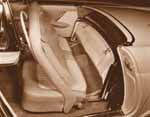 The initial design task was provided for a car weighing about 1100 kg, with a V-shaped eight, capable of developing 100 miles per hour (160 km/h), with places for the driver and one passenger under a soft folding top. At the same time, the design should have used the maximum possible number of ready -made, mass -produced nodes and details - a circumstance dictated by considerations of rigid saving time and means.
The initial design task was provided for a car weighing about 1100 kg, with a V-shaped eight, capable of developing 100 miles per hour (160 km/h), with places for the driver and one passenger under a soft folding top. At the same time, the design should have used the maximum possible number of ready -made, mass -produced nodes and details - a circumstance dictated by considerations of rigid saving time and means. The last condition has significantly facilitated the task of designers from Boba Magire Bureau, who received only three months for the first layouts. The short -term terms did not allow us to engage in large -scale models in such cases, and full -sized painted layouts were presented at the first shows. From the very beginning of the work, an emphasis was placed on the straightforward style of the body of the future car. At that time, Ford players played auxiliary role in engineers, but in this case they were determined not only to hide the body for a shortened chassis of a standard sedan. Starting with a clean sheet, the designers put forward the demand to lower the engine below and move it back a little more than it was dictated, although unwritten, but generally accepted norms.
Due to the universal enthusiasm that surrounded the project, they managed to achieve what they wanted.
In early 1954, the work was mainly completed. To start the production of a new model, an impressive name attracting the public was required.
Like all real legends, the history of the now wide -known name Thunderbird is one third of the truth and two -thirds from rumors and the game of imagination. Ford advertising agency offered such pearls as BeAver, Flag Liner, Hep Cat, Whelaway - we want to propose to independently translate. None of the names reflected either the true spirit of the new car, or the expectation of customers. I even had to announce a contest with a prize in the form of a costume at a cost of two hundred and fifty dollars. The winner was one of the Ford designers. From that moment on, the company received at least one well -dressed stylist, and at the same time the name of the car, which made the hearts of more than one generation of Americans be fought.
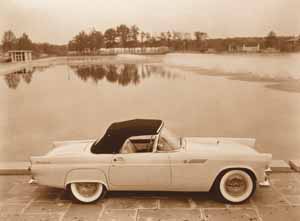 The first generation T-Bird constructively was quite conservative. The body, which was distinguished by extremely low stiffness, was mounted on a traditional biennelon frame, reinforced in the middle part with diagonal ties. In front of the chassis was based on an independent lever suspension with shock absorbers and cylindrical springs, while the back suspension was dependent, on semi -elliptical springs. It is interesting to note that in connection with the acceleration of work, the first tests on the go were carried out on a shortened chassis of a serial sedan, which resulted in the use of softer, than usual, springs in the front suspension and shorter springs in the back. All wheels had drum brakes. The engine displaced back gave the original weightlift 49/51.
The first generation T-Bird constructively was quite conservative. The body, which was distinguished by extremely low stiffness, was mounted on a traditional biennelon frame, reinforced in the middle part with diagonal ties. In front of the chassis was based on an independent lever suspension with shock absorbers and cylindrical springs, while the back suspension was dependent, on semi -elliptical springs. It is interesting to note that in connection with the acceleration of work, the first tests on the go were carried out on a shortened chassis of a serial sedan, which resulted in the use of softer, than usual, springs in the front suspension and shorter springs in the back. All wheels had drum brakes. The engine displaced back gave the original weightlift 49/51. The promises of good controllability read in these figures were nullified by the unsuccessful design of the suspension, which had a characteristic more like a car for boulevards than a sports car. Ford later continued experiments with suspension parameters, but only in order to compensate for increasing the weight of the rear of the car in 1956. However, no matter how Ford tried, T-Bird's handling still left much to be desired.
Under the hood of the Ford Bird - in contrast to the six -cylinder engines of the first Corvette releases - a V -shaped eight immediately stood up. At first, these were Mercury engines with a volume of 4785 cm cubic meter, developing 198 hp. and demanding about 11 seconds. To accelerate the car from a place to 60 miles/h. A three -stage box was placed in the block with the engine, and the buyer could choose between an automaton and a mechanical version.
The first prototype was already in a good one and a half hundred kilograms heavier than the design weight, and in the winter of 1953-54, Cruisor decided to transform the car from a purely sports, personified car with powerful brakes, comfortable seats, lifting side windows and a hard top as an option. The goal of Ford became truly dynamic, but not at the expense of comfort, a car. As a result, the first serial machines weighed nearly one and a half tons.
Although the filling turned out to be generally template, Ford hit the apple with the appearance of the car. In the design of the body, clean, simple, but at the same time stylish lines of a long hood and a relatively short trunk were used. In general, the low, licked and deprived of unnecessary jewelry of the body on a short (2590 mm) base looked very elegant.
Excessively large cuts of the arches of the rear wings, which looked simply absurd, were later covered with panels that partially hid the wheels.
The car, which gave the car, the stamping on the hood, on the contrary, was functional, hiding the air filter under it. The bodies were made at one of the specialized enterprises, then painted and equipped in Dirborne.
 The first car left the assembly line on September 9, 1954 - twenty months after the project was given a green light. On September 23, a presentation of a new machine was held as a 1955 model, and a month later it went on sale at a base price of $ 2695, which included a removable hard top, but without a folding soft tent offered as an option. Also, at the choice of the buyer, the steering wheel, air conditioning, and an electric drive lifting the side windows were installed on the car.
The first car left the assembly line on September 9, 1954 - twenty months after the project was given a green light. On September 23, a presentation of a new machine was held as a 1955 model, and a month later it went on sale at a base price of $ 2695, which included a removable hard top, but without a folding soft tent offered as an option. Also, at the choice of the buyer, the steering wheel, air conditioning, and an electric drive lifting the side windows were installed on the car. In the first year, a successful combination of characteristic attractive appearance, power and comfort allowed Ford to sell 16,000 birds, greatly overtaking Corvette. Now there is a turn of Chevrolet to put in races by the drawing board.
1956 made only small changes to the appearance and design of the car, which once again emphasized the correctness of the designers in the approach to solving the initial task assigned to them. But some conclusions from the lessons of the first year of production were still made. 12-volt electrical equipment changed the previous 6-volt system. A new engine with a volume of 5112 cm cube appeared as an option. with a capacity of 225 hp at 4600 about./min. Due to the additional horsepower, the car that had been covered by another one and a half hundred kilograms improved the dynamics, reducing the acceleration time to 60 miles/h about 1.5 seconds. The maximum speed was now 115 miles/h.
Most of the added weight was behind the rear axle, which, in combination with a softer rear suspension and a decrease in the gear number of the steering mechanism, slightly improved the controllability of the car. The centering even more shifted back, strengthening the tendency to rise in front of the front during acceleration - far from the best feature. That is why a year later I had to abandon the most noticeable external distinction of the 1956 model - a spare wheel mounted vertically behind the body in a decorative case, in the so -called continental style. This innovation, although it looked attractive and freed a place in the trunk, but at the same time made it difficult to access there and complicated the process of replacing the wheel.
In the same year, rotary ventilation windows appeared in the front wings and the famous hard top with round illuminators in the rear racks. Only slightly improving the visibility, he turned out to be a successful stylistic find - four out of every five buyers preferred just such an option.
And again, despite the worst dynamic characteristics, T -Bird significantly ahead of Corvette in terms of sales - 15.631 versus 5000.
Another year passed, and the appearance of the bird again underwent a number of changes. The 1957 model received new, more complex form of the bumper (the front indicators were built into the front). In the back of the body, vertical kils of small, however, for that time of universal passion with an extravagant missile style, sizes appeared. The spare wheel returned to the trunk, which became 5 inches longer - the buyers demanded enough space for a set of golf clubs, and not just a folded awning and reserve. Another innovation - many, however, considered it an unnecessary whim - was the sound volume of the radio, automatically changing depending on the speed of movement, which saved the driver, the passenger and all those around the stunning at each stop.
There were already four engine options to choose from, the largest of them had a volume of 5768 cm cube. and power over 300 hp A series of a hundred specially prepared cars with a 5112 cube engine equipped with a PAXTON supercharged and developed 325 hp was also released. And at the end of the decade, as a response to the most charged Corvette fuel injection, it became possible to install individual components produced by the Ford in accordance with the rules of the Nascar Body Cars Championship. But all this had little in common with the mass -produced model, the sales of which continued to increase - more than 21,000 by the end of 1957.
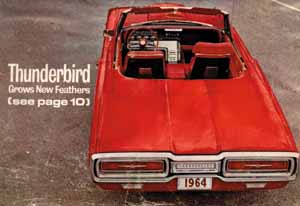 It was the expansion of the sales volume that prompted the company to create an independent division of Thunderbird in the late 50s. Some comic of the situation was, however, that this happened precisely when the car began to grow, finally gone beyond its original sports image. Perhaps even greater success would be possible, provided that the brains of the Ford Administration would continue to work in the line of the original Crusoe concept. Indeed, even in the early 60s, the idea of \u200b\u200bresurrecting the original body was seriously discussed, mounting it on the modified Fairlane platform before the final decision was made to engage in a new model - Mustang.
It was the expansion of the sales volume that prompted the company to create an independent division of Thunderbird in the late 50s. Some comic of the situation was, however, that this happened precisely when the car began to grow, finally gone beyond its original sports image. Perhaps even greater success would be possible, provided that the brains of the Ford Administration would continue to work in the line of the original Crusoe concept. Indeed, even in the early 60s, the idea of \u200b\u200bresurrecting the original body was seriously discussed, mounting it on the modified Fairlane platform before the final decision was made to engage in a new model - Mustang. The decision of the company's management to replace the original T-Bird with a larger four-seater project dictated exclusively by pursuit of profit caused the effect of an exploding bomb among numerous fans of the laconic sports model. But the company was not up to sentiment, and the bird had to go to the ground. And her follower was already ready to take off.
The design program for the new four -seater T -Bird was launched in the winter of 1955 - only six months after the start of the first model.
At the presentation of the new car, the fans of the first T-Bird remained only to shrug their shoulders. Although four headlights replaced the former two, the 1958 model found a clear resemblance to its predecessor. But only when looking at the front. By this, along with the preserved name, their similarity was limited. With the beginning of the new project, Ford completely switched to a more prestigious market sector, giving a sporting theme to their constant opponent.
Increasing the size and number of places, Ford strategists were not addressed to windy youth, drawn in full, jumping into the convertible through a closed door and breaking off the scene in the screech of rubber and smoke from under the wheels, and to the steppe family customers.
The first -generation frame chassis was replaced by a hard supporting body, which became 610 mm longer and 100 mm wider. At the same time, the base increased to 2870 mm. The absence of a separate chassis allowed designers to limit themselves to only one extra inches of the height of the machine - and the new model looked even lower. The suspension has also changed, becoming completely independent: spring, with ball joints in front and reactive rods from behind.
The 1958 model pleased the look of fresh appearance, which nevertheless remained in the pronounced T-Bird style. As before, the outer decoration boiled down to a reasonable minimum, but this time more attention was clearly given to the body. This was especially striking when looking on the side - dictated by aesthetic considerations, longitudinal stamping of complex shapes at the same time increased the stiffness of thin steel panels of large area.
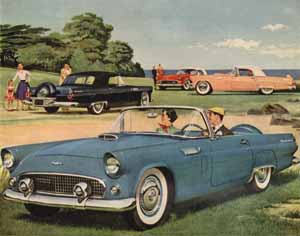 The interior of the salon due to the increased height of the roof and the appearance of the rear seat seemed unexpectedly spacious. The use of incredibly long - 1.2 m - the doors solved the problem of access to the rear seat, the passengers of which even won compared to those sitting in front, since the sharp lower corners of the panoramic frontal window were significantly interfered in the front seat. Another source of headache was for the developers the presence in the cabin of an impressive tunnel of the cardan shaft, the most important element of the stiffness of the open body. The disadvantage, however, turned into an advantage due to the use of the console, which smoothly rising from the tunnel with the tunnel with the radio, ashtray, heater handles and windows switches placed on it.
The interior of the salon due to the increased height of the roof and the appearance of the rear seat seemed unexpectedly spacious. The use of incredibly long - 1.2 m - the doors solved the problem of access to the rear seat, the passengers of which even won compared to those sitting in front, since the sharp lower corners of the panoramic frontal window were significantly interfered in the front seat. Another source of headache was for the developers the presence in the cabin of an impressive tunnel of the cardan shaft, the most important element of the stiffness of the open body. The disadvantage, however, turned into an advantage due to the use of the console, which smoothly rising from the tunnel with the tunnel with the radio, ashtray, heater handles and windows switches placed on it. No T-Bird could be considered a light car, but unexpectedly for many, a new car gained only 200 kg in weight. Increased to 300 forces and engine power with a volume of 5768 cm cubic meter, which developed 20% more torque by 20%. A three -stage mechanical box with a raising gear or machine gun was supplied to the choice. For an additional fee, a 350-horsepower engine with a volume of 7046 cm cubic meter was set, equipped only with an automatic transmission.
The most common complaint, especially from the experts, was still poor handling. Nevertheless, a spacious, comfortable, affordable (base price was $ 3630) The car instantly became a hit for many American families. Ford hopes for increasing profit came true - more than 35,000 birds were sold in 1958.
The changes in the 1959-60s were extremely insignificant and were mainly cosmetic. Nothing was done to improve handling.
The reason, apparently, was covered in the fact that the lion's share of the funds provided for the modernization was eaten at the design stage. In 1960, a fully automatically cleaned soft roof appeared, which occupied almost the entire trunk in a folded position.
1959-60 were successful for T-Bird: the total number of cars sold reached 147,000. But, despite these excellent indicators, Ford again studied the needs of the market and prepared a new sharp turn in the history of the bird.
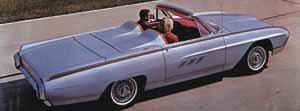 Comparing the shock caused by the change in the T-Bird concept in 1958, which at once turned into a boulevard cruiser, with a calm reaction to a new model of 1961, we can say that this time there was a rather evolution than a revolution. Preserving the previous dimensions, the thunder-bird of the third generation appeared dressed in a completely new body of smoothly flowing forms. Pure, calm, modern exterior lines characterized a new machine.
Comparing the shock caused by the change in the T-Bird concept in 1958, which at once turned into a boulevard cruiser, with a calm reaction to a new model of 1961, we can say that this time there was a rather evolution than a revolution. Preserving the previous dimensions, the thunder-bird of the third generation appeared dressed in a completely new body of smoothly flowing forms. Pure, calm, modern exterior lines characterized a new machine. The double headlights are drowned under a laconic sloping hood, the line of which, smoothly rising up and stretching over the entire body, ended with moderate keels on the hind wings. The emphasis was on the back on the round lanterns integrated into the bumper. The car, as before, was offered in the variants of hardtop and a convertible with a folding soft top. With the preserved base, the length of the cabin increased by a good 250 mm. The body, consisting of two welded parts collected together, became lower, which only increased its attractiveness. The convenience of landing and landing was helped not only by a large doorway, but also by the absence of an uncomfortable window ledge in front, as well as a steering wheel that can deviate 250 mm to the right in a fixed car. This innovation was especially appreciated by tall drivers.
The volume of the only proposed engine with one upper camshaft increased to 6384 cubes. The power remained at the mark of 300 hp, but the moment increased by about 10%, and the acceleration time from a place of up to 60 miles/h was 10.5 seconds. The car was equipped only with an automatic box, brake and steering amplifiers became standard equipment.
With a significantly improved review, conveniently located devices and controls, a high level of comfort, the new T-Bird more consistent with its prestigious purpose. Its sled qualities were also significantly higher than that of the predecessor: the brakes became more reliable, the rotation is easier, the body roll in corners decreased, the ability to keep the road improved - all this helped forget about the fuzzy reactions of the previous model. However, it was still not possible to completely get rid of the deficiency shortcomings - the problems with the suspension pursuing Ford and still insufficient brake force made the complete control of the machine weighing more than 1.5 tons problematic.
The standard version of the car was subjected to the minimum of changes next year, and they did not go further than decorative chrome things - well, the Americans could not afford to release the same model for two consecutive years! Even if there was no need to change something.
But a special model was seen, as if returning to the enchanting period of double bodies - Sport Roadster. Its most noticeable external distinguishing feature was a stylized aerodynamic panel from Fiberglas, overlapping the space above the rear seats and having built -in head restraints for the front ones. And to look even cooler, the car was equipped with sprouted wheels.
Under the hood of the SR version, the coveted 340-horsepower version of the well-deserved eight, whose power was achieved by an increase in the degree of compression to 10.5, was hidden. Sports T-Bird had an irresistible appearance, more than sufficient power and hard, very tough for a convertible, body. However, he did not make a big impression on the public. The sales was at a low level, and the car lasted only two years in production. On the contrary, the standard option with a tough, trimmed with vinyl and stylized decorative circuls on the rear racks of the roof turned out to be very successful.
1963 again brought only variations on the topic - the machine was well sold, and there was no point in violating this process, making radical changes. Instead, the main news for the adherents of the Big Bird was the appearance of another small -scale model - Limited Edition Landau. The representation of the car in Monaco actress Grace Kelly was accompanied by a deafening advertising campaign and unusually great attention from the press. In total, 2000 copies were released. Princesses Grace. Her elegant body, painted in white, crowned the hard top trimmed with pink vinyl, and the interior of white skin was finished with pink wood with panels. For a relatively moderate price, the owner of the princess could feel himself joining the brilliant world of crowned persons. At least for a while.
From the point of view of the mechanics of T-Bird 1964, the model year again remained unchanged, but the body clearly carried traces of plastic surgery. Pure, with a small curvature panel, gave way to a whole set of planes and stamping, reminding many of the appearance of the previous generation machines. Ford categorically denied the intention to turn back the clocks, but the similarity was too obvious. Nostalgic feelings caused an altered front and lack of side fins. The rectangular blocks of the stop signal and the turns of the turns with the overlays in the form of a stylized image of the thunder-bird appeared from behind.
The only constructive novelty, far from fundamental, was exhaust ventilation. The trunk volume has increased significantly, which still occupied a folded awning from the convertible. The still proposed Sport Roadster, which had a slight demand, was a weak compensation for this.
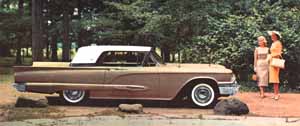 Even with minimal external changes, the 1965 model, strongly reminiscent of the style of the late 50s, still could well force friends and acquaintances of the owner to green with envy. But, finally, a significant step was taken forward - T -Bird became the first Ford car equipped with disc brakes as standard equipment. And on time, because the weight of the car exceeded far over a couple of tons. Now the inhibition process has ceased to be something like a trick from which the hair stood on end. And the inscription Disk Brake even appeared on the brake pedals so that the driver does not forget what he is dealing with.
Even with minimal external changes, the 1965 model, strongly reminiscent of the style of the late 50s, still could well force friends and acquaintances of the owner to green with envy. But, finally, a significant step was taken forward - T -Bird became the first Ford car equipped with disc brakes as standard equipment. And on time, because the weight of the car exceeded far over a couple of tons. Now the inhibition process has ceased to be something like a trick from which the hair stood on end. And the inscription Disk Brake even appeared on the brake pedals so that the driver does not forget what he is dealing with. However, it is unlikely that every time, clicking on the brake, someone first looked at the pedal ...
A curious novelty was the rear three -section rotation indicators. The first section was the first to turn on, followed by an average and, finally, external. And all this Christmas tree garland served only in order to brightly, in the literal and figurative sense, to show the intention of the driver.
The next one, 1966 added the last strokes to the history of two -door bodies. The modification has touched - for again! - The grilles of the radiator and which became similar to the narrow blade of the front bumper - the front of the car has become cleaner. And the new blocks of the rear lights now occupied almost the entire width of the body.
As options, a 315-horsepower engine with a volume of 6384 cm cube was offered. or a seven -liter engine with a capacity of 345 hp.
The design of the late Bigbird was quite controversial, and yet only a few competitors could argue with its popularity: in 1964-65, the company sold more than 170 thousand birds. And yet ... nevertheless, after twelve years of production, Thunderbird's youth ended. Time inexorably took its own, the appetites of buyers demanded more and more chic cars. Buick and Oldsmobile models rapidly won the market. Ford was determined not to miss its piece of pie, and therefore the first four -door Thunderbird was, as they say, literally around the corner. But this is the topic of another story.
Despite the fact that the last classic bird flew out of the assembly line more than 30 years ago, interest in cars is still very great. Of the 52,000 Littlebird, 194,000 Squarebird and 430,000 Bigbird, a significant percentage, thanks to the efforts of numerous collectors and restorers, is still on the go and in excellent condition. Apparently, this was so driven into the blood that many who had T-Bird in the 50s-60s are now returning to their classics. And they often know the story of their car better than their pedigree.
Vladimir Knyazkov
Source: Magazine Motor

